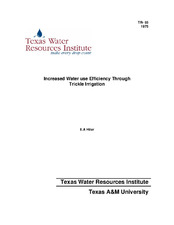| dc.description.abstract | The gap between supply and demand of water for agricultural and municipal uses is rapidly closing at a time when world food requirements are increasing at an alarming rate. To meet the demand for agricultural products, new lands must be brought into production or higher yields must be realized from existing lands. In either case, more efficient use of water is prerequisite. Trickle irrigation is an approach to obtain increased water use efficiencies (ratio of weight of grain harvested to weight of total crop water use) and therefore a way to increase food production with our limited water resources.
The ultimate goal of this investigation was the development of required crop inputs for selected crops to optimize the design of trickle irrigation systems and obtain an optimum water balance for living plants. Specific objectives were as follows:
1. To quantitatively determine optimum irrigation timing and necessary water application amounts for selected crops when using trickle irrigation; and
2. To develop a general method for the hydraulic design of trickle irrigation systems using inputs from the first objective for optimizing the system.
To achieve these objectives, experiments were conducted in field lysimeters and in a well-instrumented field plot installation for evaluating the crop inputs. Complete control of the soil water balance can be achieved by the use of these facilities. By knowing the required crop inputs and utilizing known principles of fluid mechanics proper design procedures were developed to provide optimum design for trickle irrigation systems.
To achieve the first objective, three research experiments were conducted at the research lysimeters of the Department of Agricultural Engineering at Texas A&M University for which grain sorghum was selected as the experimental crop. The first two experiments were designed to study the response of grain sorghum to trickle and subsurface irrigation. A comparison of water use efficiencies under well-watered conditions using both intensified and conventional water application methods and the evaluation of water use efficiencies with trickle irrigation applications designed to limit the availability of water were the specific objectives. The results indicated higher water use efficiencies and better crop response when the trickle method of application was used. Also, the results showed that higher water use efficiencies can be obtained by applying sparing amounts.
An additional investigation carried out under a different research project of the Texas Water Resources Institute (TWRI Project No. A024TEX) was designed to develop a computer model to simulate grain sorghum yield and water use under high frequency irrigation. The simulation methods used in this study can be used to simulate a complete irrigation experiment greatly reducing research costs and allowing the determination of water requirements for many crops under many different soil and climatic conditions.
The objective of the third research experiment conducted in 1974 was to determine if different irrigation frequencies would influence the growth and water use efficiency of grain sorghum when irrigated at optimum levels. Results indicated that frequency of application had no significant effect on the water use efficiency of grain sorghum for irrigation intervals up to 7 days.
To attain the second goal of this investigation two trickle irrigation lateral design methods were developed. With the first method the pressure loss and emitter flow ratio for trickle irrigation laterals can be determined. The design method is based upon known principles of fluid mechanics. A computer program was written to determine the lateral pressure loss and emitter flow ratio at a given design length as function of pipe size, tree spacing, number of emitters per tree, emitter spacing, downstream lateral pressure and lateral slope. For a given set of design inputs, the program can be used to determine if the given pipe size will be adequate to limit the pressure loss and flow variation along the lateral to limits acceptable for the design lateral length. In the second method design equations are utilized to calculate the maximum lateral length for a given value of the uniformity of application coefficient. The solution depends upon the emitter flow function, elevation change, pipe size, reduction coefficient for dividing flow, pipe roughness coefficient, the average emitter flow rate, and either the average emitter spacing or the number of emitters per lateral. For a given uniformity the solution is a linear log-log line with a slope that depends only on the flow rate exponent in the pipe friction loss equation. Dimensionless graphs were developed that can be used to design the trickle irrigation laterals.
It is believed that the results obtained in this research would provide far-reaching state, national and international benefits. | en |


